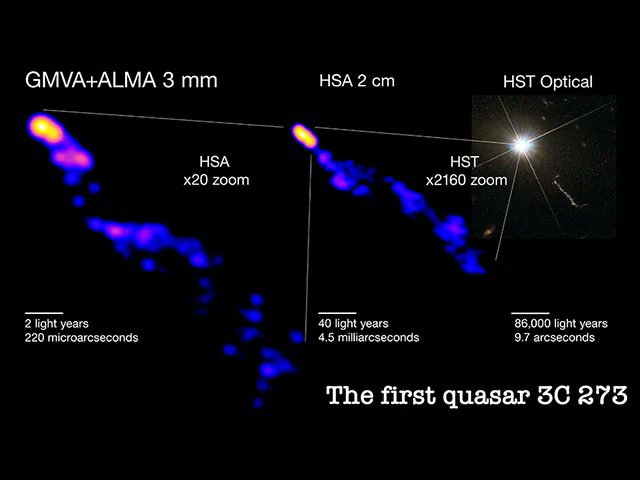New technologies bring new astronomical insights, which is especially satisfying when they help answer debates that have been ongoing for decades. One of those debates is why exactly the plasma emitted from pulsars “collimates” or is brought together in a narrow beam. While it doesn’t provide a definitive answer to that question, a new paper from an international group of scientists points to a potential solution, but it will require even more advanced technologies.
The paper takes a look at the first quasar ever found. Now known as 3C 273, it was discovered back in 1959 and is several billion light years away from Earth in the direction of the constellation Virgo. It is likely the farthest object amateur astronomers can see if they use a standard telescope. However, that is relatively close for a quasar, so it has been the focal point of dozens of studies regarding these massively powerful objects since its discovery.
One feature that 3C 273 and many other quasars share is that they emit a jet of plasmatized matter out of their core at close to the speed of light. This plasma jet typically extends far past the quasar, a type of supermassive black hole, that created it. So far, in fact, that it typically extends past the bounds of the galaxy surrounding its parent black hole and begins to contribute matter to the intergalactic medium, thereby shaping the formation of new galaxies.
During its formation, the beam is brought together, which allows it to travel much further than would otherwise be possible. This would be analogous to a laser, which essentially does the same thing for light by bringing it together into a coherent state and allowing it to travel far distances without disruption.
Scientists have puzzled for years about what brings about this collimation that allows the plasma to travel as far as it does. However, they could never get a good look inside the base of the beam to understand the physics there. These quasars are billions of light years away, so that isn’t that surprising.
But humans are ingenious problem solvers, and a team led by MIT devised a way to leverage some of the best telescopes in the world and make them even more capable than they would be separately. Utilizing a technique called very long baseline interferometry (VLBI), researchers were able to link up six different sets of telescopes, including ALMA, one of the world’s most powerful and a key contributor to this research.
Its 66 telescopes, linked with others using the VLBI process, created what is effectively the world’s best interferometer. And the images it, along with its interconnected partners, returned were stunning (see banner picture). However, while these were the highest resolution images of a quasar plasma jet yet, they still weren’t enough to determine what actual physical process was going on.
That next step might require another amazing piece of new tech. Quasars are, after all, black holes, and what better instrument to check out what is going on near a black hole than the Event Horizon Telescope, which famously provided the data to directly image one back in 2017. It measures at higher frequencies than ALMA, allowing researchers to look more closely at the C3 273 jet and those that are farther away, which could prove whether C3 273 is unique or typical of its type.
Coordinating that will take some more doing, but, as one of the paper’s author’s put it in a press release, they already have plenty of “homework” to do with the data collected so far. More technological advances are sure to bring on more spectacular images and maybe a definitive answer to this long-standing question – someday, anyway.
Learn More:
MIT – International team observes innermost structure of quasar jet
UT – What Is A Quasar?
UT – Gravity Really Tangled up the Light From a Distant Quasar
UT – Astronomers are Starting to Understand the Quasar Lifecycle
Lead Image:
New detailed images of quasar 3C 273 using the VLBI technique, ranging from the most detailed (far left) to an image from Hubble (far right).
Credit – Hiroki Okino and Kazunori Akiyama; GMVA+ALMA and HSA images: Okino et al.; HST Image: ESA/Hubble & NASA

